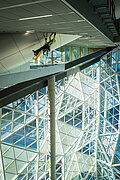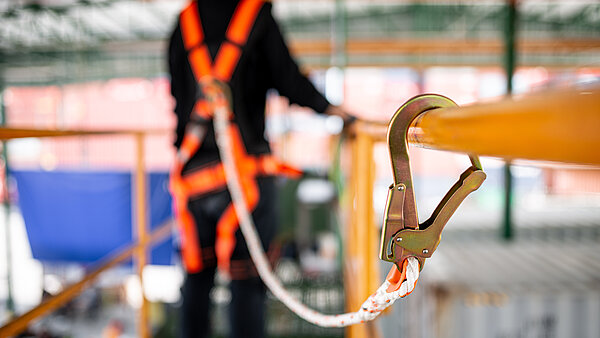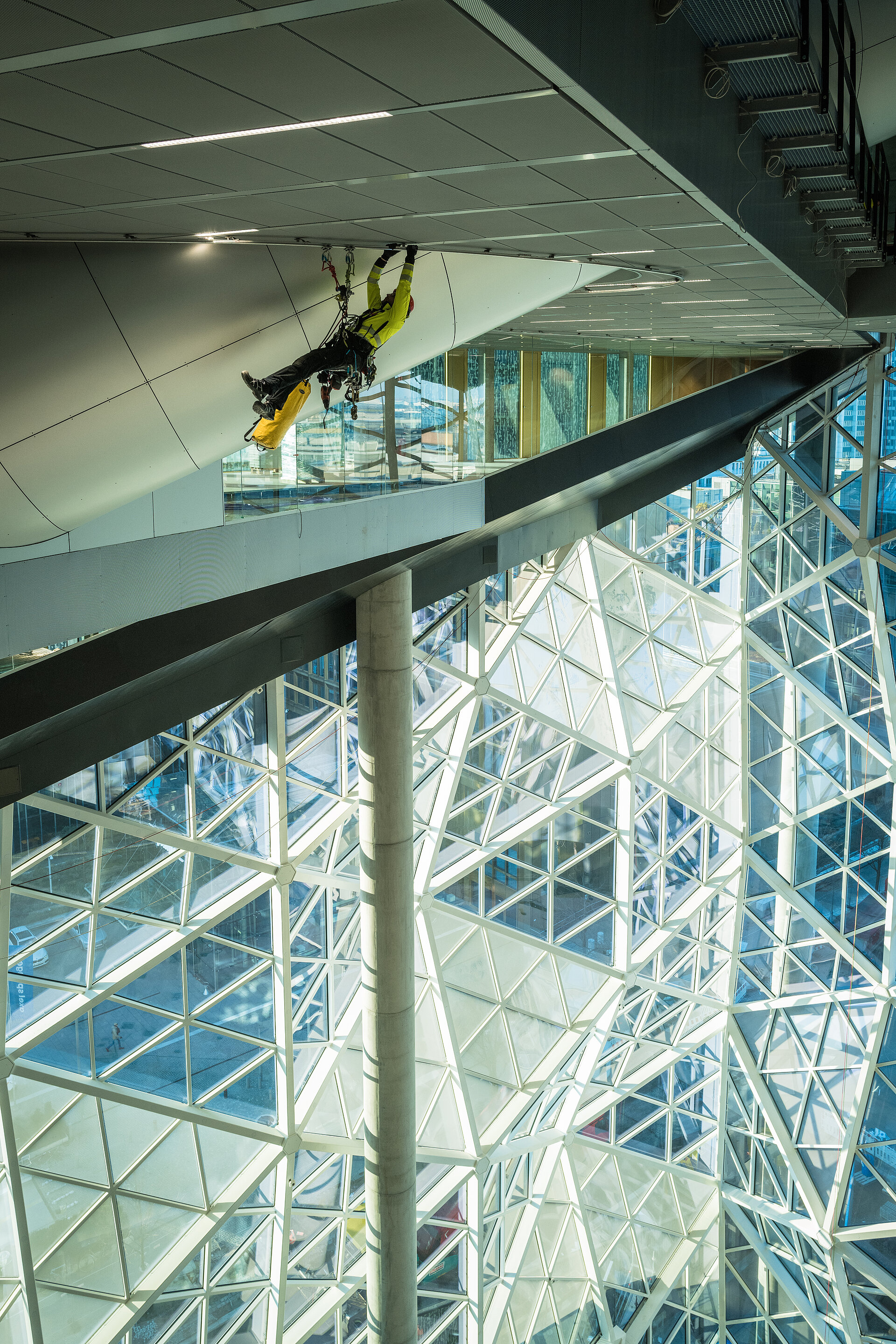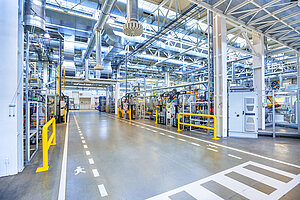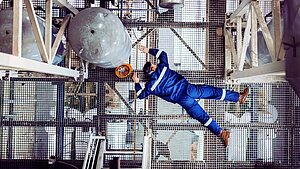Industrial operations require real fall protection, because the illusion of safety can have fatal outcomes not only for employees, but also for the company itself. The examples of use for safety systems go from working on cranes, large-scale machinery, robots, to fire engines and much more. On the one hand, because of laws and legal standards, companies are obliged to ensure that employees are appropriately protected, and on the one hand investigations into the Return on Prevention indicate that industrial safety is always more cost-efficient than an accident, possibly caused by a fall having fatal consequences. The following 4 Best Practice examples for fall protection in industry indicate the safety-relevant challenges faced by successful industrial operations in Austria, Germany, and Switzerland, and how these challenges are overcome.
Best Practice #1: Fall protection for Liebherr
Liebherr is a traditional family-led group consisting of ten companies in the areas of handling equipment, rotating tower cranes, mobile and crawler cranes, mining, aerospace, traffic engineering, and other fields of activity. The fundamental values of the Austrian affiliate founded in 1960 include appreciation of its own employees who work loyally and faithfully year in, year out for the Liebherr family. In the Liebherr Nenzing works in Vorarlberg, the industrial operation required a reliable and professional fall protection system, because the safety of the workforce had to be ensured at all times during the assembly of the LR 1250 crawler crane.
Challenges
During construction, assembly, and servicing tasks, the crane’s boom arm is lowered, and so it is only 2 to 3 metres above the ground. Because of the reduced height, a safety system with cable deflection is not possible, yet a fall must be avoided. The large gap between the rails represented a further challenge.
Solution
The solution for Liebherr consisted of an individually developed TAURUS rail system made from aluminium, with two additional rails to left and right of the walkway. In this way the fall height is reduced significantly, while the users are additionally secured using double HSG fall arrest devices and INNO|String 01 Basic. While building the crane boom, they are able to work quickly and safely, without having to detach or reattach themselves.
Source: https://www.youtube.com/watch?v=b0md1_M85Qo
Benefits
The TAURUS system, developed in aluminium, can also be adapted to cranes of an earlier generation, as well as to new and existing machines
Thanks to the extremely long slider, downward-folding openings in the maintenance walkway can be negotiated jerk-free and safely
The String 1 Basic PPE and double HSG fall arrest device adjust themselves automatically to the movements and size of the user
The locking function of the HSG is always under tension, and grips the user immediately and reliably in the event of a fall
Changes of direction within the safety system are possible at any time without readjustment
Best Practice #2: Fall protection system for Fill
The Fill Gesellschaft m.b.H. family company in Gurten, Austria, which makes machinery and plant, is amongst worldwide industry leaders, and is proud of its many awards, such as the Austrian bronze state prize for family and working life 2018 and ineo - exemplary companies for training 2019-2022. Because the industrial operation provides maximum industrial safety for its roughly 900 employees, Fill sought a reliable safety solution for the servicing of its robots.
Challenges
For maintenance and service tasks on Fill’s gantry robots, the fall space is very small, and therefore only a very small cable deflection is permitted. The fall protection system could not be attached to the ceiling, because many structures were already present. The particular requirements therefore meant that an individually tailored special solution had to be developed and manufactured for the operation.
Solutions
In order to raise the height of the entire safety system and to increase the fall space, the company had its own steel structure built, and the 8mm cable system was attached directly to this, using End-10. The higher the anchor point, the shorter the cable length and therefore the fall. The fall protection system is now located roughly at the chest height of the users, who are secured by the HSG fall arrest device.
Benefits
Low cable deflection thanks to direct attachment to the steel structure (at chest height)
Significantly reduced risk of falling, because of the low height and the steel structure

By loading this video, you accept Google's privacy policy.
Best Practice #3: Fall protection system for Rosenbauer
Now in its sixth generation, for more than 150 years internationally active Rosenbauer International AG has served fire brigades all over the world. The industrial group develops and manufactures vehicles, extinguishing technology, equipment, systems for preventative fire protection, and digital solutions for fire brigades. So that the employees in final assembly enjoy all-round protection in the workplace, the company needed a suitable fall protection system for working positions at height at their Leonding production site.
Challenges
The fall protection system at Rosenbauer is required for tasks at height, such as the final installation of spare tyres, final inspections, or quality control before delivery. The challenge was that the site’s wall elements were not load-bearing because of their lightweight construction, and therefore a structural engineer was consulted when planning the fall protection system.
Solution
Because of the requirements profile for the safety system, and in consultation with the metalwork constructors, the structural engineer was able to develop a suitable steel support for the end points, using tensioned spring supports where the major force arises. It was possible to attach the AIO standard system to these supports. The system uses overhead attachment and, if required, has a very long span. The users move flexibly over the vehicle roofs in the assembly hall, thanks to the slider (GLEIT-11). This travels to and fro, and the users are attached using the HSG fall arrest device. Maintenance, inspection, and servicing tasks, as well as minor installation tasks, can be undertaken while secured by the system. No additional scaffolding is necessary, even for rectification tasks, so they can be performed quickly and with little difficulty.
Benefits
The fall protection system is now used without exception because of its user-friendliness
The users benefit from great freedom of movement because the lanyards are positioned at the fall arrest eye of the anti-fall PPE
The full cable length can be used because the end lock and intermediate brackets are attached to the concrete or steel support
Best Practice #4: Fall protection system for IMAK
Since 1997, IMAK Anlagenbau GmbH has specialised in activities such as machine engineering and installation, relocation of equipment, steelwork, servicing of paper machinery, bearing maintenance, etc. Performance and quality are just as much a priority here as maximum customer satisfaction. For regular maintenance and inspection tasks on a floating crane, the company required safe all-round access right to the tip of the crane, in order to prevent the user from falling into the water or onto the deck of the boat.
Challenges
Because the ladder at the side of the floating crane is folded up in regular sections, the safety system is repeatedly interrupted, and the fall protection system can be positioned only in subsections. In addition, the construction has no attachment points, and they cannot be mounted directly on the ladder because of its flexible folding function. An appropriate fall protection system has to ensure that secured access to the boom arm can be provided regardless of its inclination.
Solution
Because the boom of the floating crane is generally inclined horizontally at the bottom, and then increasingly steeply further upwards, a special rail system with a TAURUS Allround slider was installed. Thanks to the integrated centrifugal brakes, the cable feed is blocked in the event of a fall, and so the fall height is very small. The floating crane can therefore be accessed safely and flexibly at any inclination, whether horizontal, sloping, or vertical.
Benefits
While working on the floating crane, the users are optimally secured in every section, regardless of the boom’s inclination
The Allround slider protects not only vertically and horizontally, but also at intermediate angles
Thanks to the slender structure of the rails and the positioning next to the walkway, it was possible to find a solution for the cramped situation
The special sliding block connection does not constrain/impair the expansion of aluminium and steel bases, which can take place without restriction
Summary: The right fall protection system for every requirement
Every company has its own requirements for industrial safety. For this, professional fall protection is always based on a holistic safety concept which is practical, reliable, and flexible.
Would you like to find out more about sustainable safety concepts in industrial operations? Then download our manual about fall protection in industry now, free of charge.






